Excel Presentation of cost of arable land in Ukrainian
Why is the price per hectare of land in Ukraine so low? What is the potential for growth in the price of hectares of Ukrainian land and what are the fundamental macroeconomic facts that justify it? An overview of the most important factors and the calculation of the real value of the most fertile land in the world is described in detail in this article.
Ukraine as a new world center for the agricultural sector of the economy
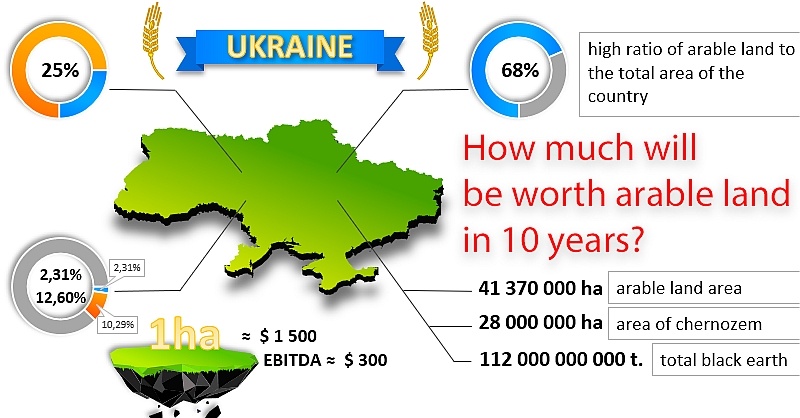
Below you can download the info graphics template with the calculator below in Excel format.
Ukrainian land today is the most attractive investment in the world for the next 10 years and here's why.
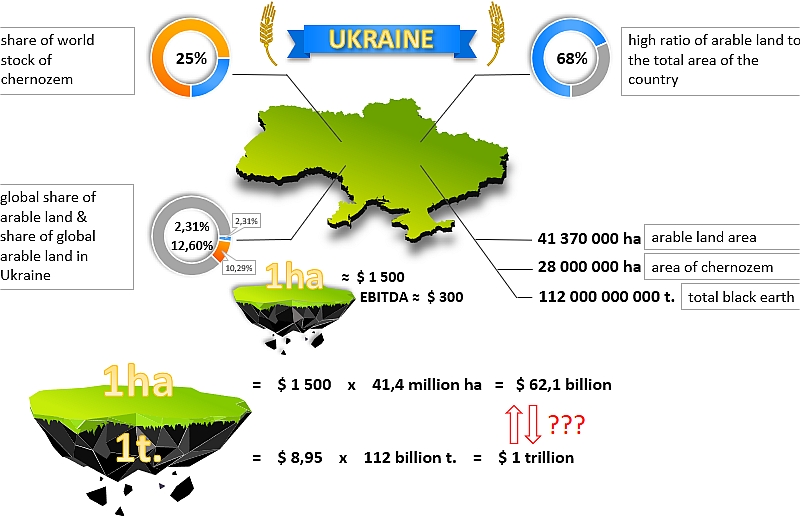
The agribusiness industry ranks 4th in the world in terms of investment capital. Quality black earth is one of the most important security factors for investments in agribusiness. The largest amount of black earth is located in the country of Ukraine - 25% of the world's reserves. In addition, Ukraine has the highest ratio of cultivated land in relation to the total area of the occupied territory - 68.38%. According to the U.S. Geological Survey arable land in the world is only 12.6% of the Earth's land surface. At the same time 2.31% of the world's arable land is in Ukraine. The total cultivated area of Ukrainian land is 41.37 million hectares.

Interesting fact! Ukraine ranks first in the world in the production and export of sunflowers, not only because of its rich soils, but also because of a favorable climate for sunflowers and the geographical location for the export of the crop. Ukraine is also a world leader in other crops.
Ukraine's leading position in the agro-industrial sector:
- place in the world in production and export of sunflower and vegetable sunflower oil.
- place in the world for the volume of exports of all crops.
- place in the world for the cultivation and export of corn.
- fourth-largest exporter of agricultural products in the EU.
- export of barley.
- wheat export.
It is important for investor to mention that Ukrainian lands are not simply arable, but also have a lot of black earth. This fact significantly exposes Ukraine on the background of developing countries in the world economy.
How much should Ukrainian arable land really be worth?
Let's make a brief investment analysis to determine the growth potential of land value in Ukraine over the next 10 years. Each investor should always determine the entry point and the exit point of investment. After all, every investment object has its own life cycle, just like any commodity.
There are legends about productivity of Ukrainian soil: "stick cane in Ukrainian chernozem, and it will bloom and give 3 crops per year". The area of black earth in Ukraine is 28 million hectares. And the thickness of the chernozem (is a black-colored soil containing a high percentage of humus) layer can vary widely: from 25 centimeters to as much as 1.5 meters (60 inches) deep. If we take as an average the chernozem layer of 40 cm, its total volume in Ukraine is 112 billion tons. That is:
0.4 meters x 28 million hectares x 10,000 meters in 1 hectare = 112 billion tons.

Download the land price calculator in Excel
Therefore, you cannot compare the amount of black earth in the world only in hectares - volume and weight are also important. The total surface area of the earth is 51 billion hectares, of which 14.9 billion hectares is the total land area. On land only 1.87 billion hectares are used for arable land. And there is a total of 300 million hectares of black earth in the world and this figure is constantly decreasing. For example, it no longer exists in Canada. Also, the amount of humus (the main organic matter in fertile soil) in the world's black earth is constantly decreasing due to human activity.
It is important to note that in Israel, Ukrainian black earth is sold in bags at a wholesale price of $ 8.95 per 1 ton! Does this mean that at the moment there is about $ 1 trillion (112 billion tons x $ 8.95 = 1 trillion U.S. dollars) worth of black earth in Ukraine at wholesale price?
After the land market opens in the current year of 2021, the value of 1 hectare is about $1,500 per hectare - that's the national average (depending on the region). That is, the price is too low as the total value of arable land (where all the 112 billion tons of black earth is) at $1,500/ha is only $62 billion. That is:
41.37 million hectares of arable land x $1,500 = $62 billion.
Consequently, land in Ukraine is now undervalued by at least 13 times!!! By rough calculation $ 1 trillion / 41,370,000 hectares = $ 24,172.11. Consequently, 1 hectare of arable land in Ukraine should be much more expensive - not less than $ 24 172.11!
But why was formed such a low market price of arable land in Ukraine? It's all very simple. The average EBITDA after processing and harvesting from 1 hectare of Ukrainian arable land today is about $ 300 per year. That is, the payback period of investment at roughly 5 years (20% per annum). In any case, the growth potential of the price of pasha in Ukraine is very high, and the price is very attractive to investors.
The growth potential of the price is very high, because the price of food is actively growing with the growth of the population of the world.
The demand for food in the world will increase by 35%!
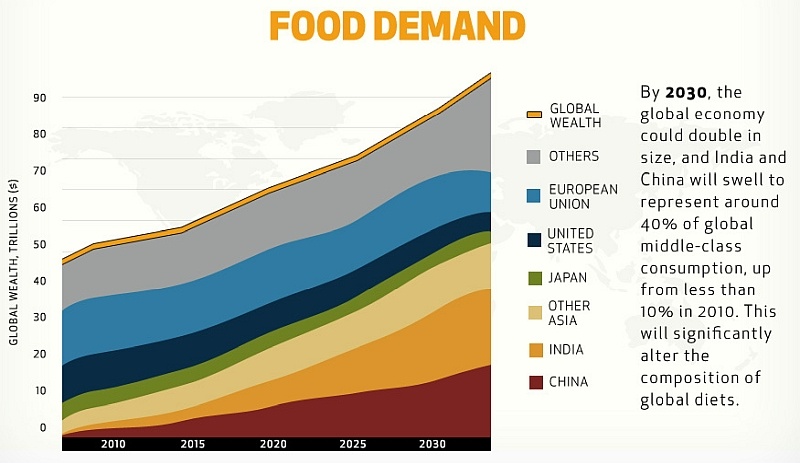
In less than 10 years time by 2030 the Earth's population will reach 8 500 000 000 people and Ukraine will be a key player in ensuring global food security in the world. By that time global economic growth will be +100%, and the most populous countries India and China will be home to about 40% of middle class consumers of agricultural products. By comparison, in these same countries in 2010 the share of middle-class consumers was only 10%.
Also do not forget that the global food system is very sensitive to world shocks: epidemics, financial crises, etc. 165 million children in the world suffer from malnutrition. And yet people around the world throw away huge quantities of usable food.
In May this year, the French parliament approved a law that forbids large supermarkets selling food products to throw away unsold but edible food. They are now required to give such goods to charitable organizations, which distribute them to the poor.
Today 75% of all food in the world comes from 12 species of plants and 5 species of animals.
The Food Pyramid of the World
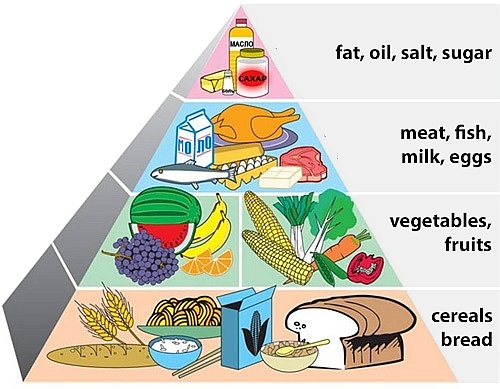
The consulting firm AT Kearney predicts:
- By 2025, 10% of the world's meat consumed will be created from plant protein;
- By 2040, 60% of the meat consumed will be non-traditional:
- 25% plant-based;
- 35% will be cultured (grown at the cellular level).
Back in 2013, UN experts developed a program for the hungry - they started feeding them edible insects (crickets, grasshoppers, beetles, ants). Edible insects are recognized as the most "waste-free" food. In crickets, 90% of the body is edible. While the slaughter yield of farm poultry reaches 75%, in pigs 65%, rabbits 60% cattle 50%, sheep 45%.
But it is impossible to feed all the hungry with crickets, especially since by 2030 the demand for food in the world will increase by 35%! Therefore, not only will the demand for plant-based agricultural products grow, but also their share in the total global consumer basket. Therefore, the curve of growth in the consumption of plant products will correlate with the growth in demand for food, but not proportionally, but ahead, even if not significantly.
Also, scientific progress makes it possible to significantly increase the quality and quantity of yields from the same cultivated area.
Scientists in the field of microbiology will increase the yield of land from 1 hectare by 2 times!
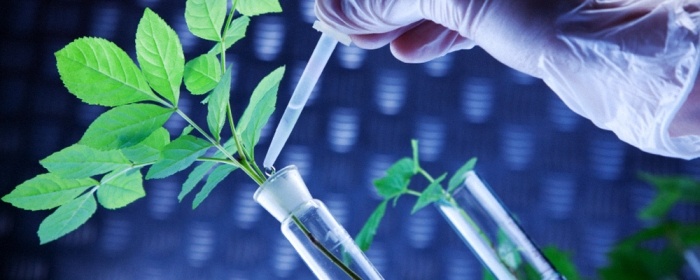
Progress does not stand still. Only 100 years ago 80% of the world's population was engaged in agricultural work, and today only 5% are able to meet even greater needs given the population growth over this period. Due to continuous improvements in high technology for the agricultural sector, farmers today are able to increase yields and get 2.5 times more yields from the same piece of land than 30 years ago.
Three stages of qualitative yield growth thanks to new agro-technologies:
- The first leap in technological yield growth was triggered by improved fertilizers.
- The second big step was the science of herbicides and genetic engineering. This approach to yield improvement has many flaws and criticisms. But whatever the case, it has influenced the growth of crop yields and this is already a historical fact. All the more it can be replaced by the next approaching 3rd, more environmentally friendly leap of scientific and progressive growth in the world agrocomplex.
- Agricultural microbiology is a branch of microbiology that studies the activity of microorganisms in agrobiocenoses and develops methods to improve the efficiency of agricultural production.
There is a new, 3rd technological leap in productivity growth per 1 hectare of land due to scientific progress. Today, scientists around the world agree on one thing - "having the soil itself gives nothing to the plant". This is an oversimplification of the world of botany. Everything is much more complex. It is not the soil itself that is important, but the whole complex of microbiological processes of organic matter, both for viability and for increasing the yield of the plant. And if you improve the quality of these same microbiological processes, you can achieve great results in the direction of increasing crop yields. And without the use of herbicides, which have a significant negative impact on plant microbiology.
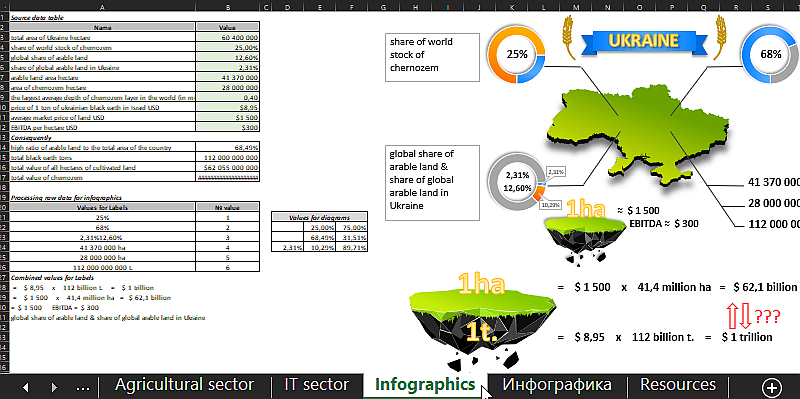
 Download Excel presentation template of the cost of arable land
Download Excel presentation template of the cost of arable land
It's time to think about the most reliable and highly profitable medium- or long-term investments!
